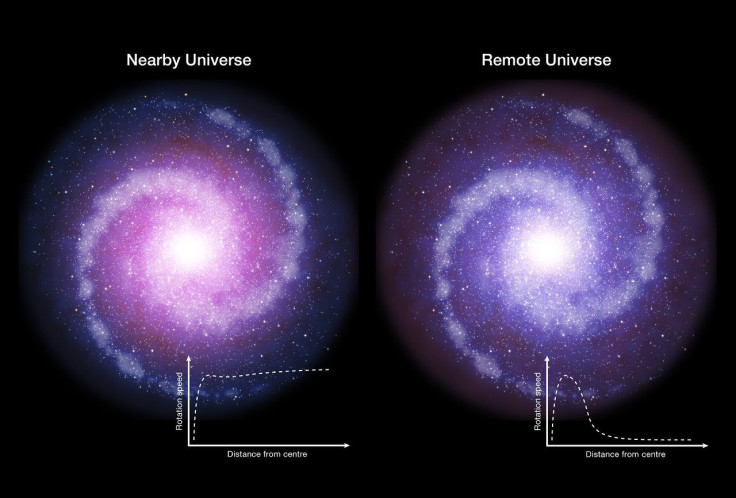Dark Matter Made Up A Tiny Fraction Of Galaxies In Early Universe

Dark matter — the mysterious substance whose presence can only be inferred through its gravitational effects — dominates galaxies in the present-day universe. Estimates suggest that galaxies born in the modern universe contain anything between 50 percent and 80 percent dark matter, and in some recently discovered galaxies, dark matter has been found to account for over 90 percent of the mass.
However, according to a new study published in the journal Nature and three in the Astrophysical Journal, dark matter-rich galaxies were not always the norm. The study, which relied on observations made using the European Southern Observatory’s Very Large Telescope in Chile, found that galaxies that formed just 3 to 4 billion years after the Big Bang were completely dominated by normal (baryonic) matter.
“These findings are supported by observations of more than 200 further galaxies, where different estimates of their dynamical state also indicate a high baryonic mass fraction,” the Max Planck Institute for Extraterrestrial Physics, whose researchers were involved in the study, said in a statement released Thursday.
Dark matter is believed to account for 85 percent of the universe’s mass. The first observational evidence for its presence was obtained in the 1970s, when the U.S. astronomer Vera Rubin and her colleagues found that stars far from the center of galaxies were moving as fast as those near the center — a phenomenon that violated Newtonian gravitational theory.
This led to the discovery that something other than the mass of visible matter was responsible for the stars’ motion — something that does not interact with normal matter through electromagnetic force and therefore does not absorb, emit or reflect light.
However, as described in the new studies, measurements of rotations of six massive star-forming galaxies in the distant (and therefore early) universe reveals that unlike spiral galaxies in the modern universe, the outer regions of distant galaxies were rotating more slowly than regions closer to the core.
This suggests that these galaxies have less dark matter than expected.
“Surprisingly, the rotation velocities are not constant, but decrease further out in the galaxies,” Reinhard Genzel from the Max Planck Institute for Extraterrestrial Physics, the lead author of the Nature study, said in a statement. “There are probably two causes for this. Firstly, most of these early massive galaxies are strongly dominated by normal matter, with dark matter playing a much smaller role than in the Local Universe. Secondly, these early discs were much more turbulent than the spiral galaxies we see in our cosmic neighbourhood.”
According to the researchers, this difference in the amount of dark matter between modern and ancient galaxies indicates that dark matter took much longer than normal matter to condense. As a result, the dark matter haloes surrounding galaxies in the early universe were much larger and more spread out — an explanation that’s consistent with other observations that have shown that early galaxies were much more gas-rich and compact than their modern counterparts.
“The dropping rotation curves are not only in line with these results, they provide a more direct indication of the baryon dominated nature, especially to researchers that have a healthy scepticism about the accuracy with which one can measure the amount of stars and gas in these distant objects,” Stijn Wuyts from the University of Bath in the U.K., who co-authored all four papers, said in the statement.
© Copyright IBTimes 2024. All rights reserved.






















